We have a basic hypothesis that most marketers and agencies are not paying enough attention to reaching users on Apple Devices using ProgrammaticAdvertising. (And probably social too, but that is a separate blog post.) We decided to run a basicexperiment comparing the delivery to Apple Devices when targeting typical 3rd party data audiences vs.our in-house cookieless tool called Pontiac ART. We have been hyper-focused on the Apple User’s Universe andthis will be the beginning of a series of blog posts called “Apple Users via Programmatic”.
Background
In November of 2021, as privacy I wrote a piece categorizing the ‘types’ of targeting and attribution which will be available across the digital ecosystem once third-party cookies are deprecated by Google. Well, that day is finally here coming before the end of 2024. In that article I broke down all internet users into three core groups:
- Cookies & Opted-In Users
- Identity Solutions
- The Un-addressable Universe
And, I still believe this is quite accurate.
Some users will still be targeted via cookies. Great.
Then there are the Identity Solutions. There are many companies offering some type of ‘identifier’ and are touting solutions that will work ‘post-cookie’, but I am skeptical about how well these ‘solutions’ will as privacy becomes an increasingly prevalent issue. I’m sure there will be some folks who can be stitched together using the UID2 from The Trade Desk or RampID from LiveRamp or one of the other solutions on the table. While these identifiers are stitched together using Publisher’s Login information, there is a clear concern that these will not scale enough.
Digiday reported today aboutthe possibility of LiveRamp exploring a sale while its stock price was faltering: https://digiday.com/marketing/amid-a-dearth-of-ad-tech-ma-liveramp-fielded-inbound-inquiries-over-a-potential-sale/. This article mentions that LiveRamp appears to shy away from publishing any numbers which clearly state the scale of the RampID; otherwise known as the ‘cookieless identifier’. In fact, for a world where we see thousands of ‘identity’ companies many of which , none of them seem to address the fact that without cookies, there must be a tremendous scale issue.
I thinkwith this being the sentiment, my prediction of the size of each group remains at-large. In a best-case scenario for the identity companies, I would think the breakdown between the groups would look like this:
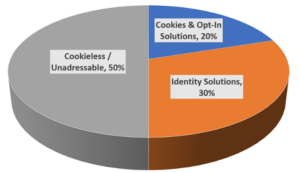
But, this grey section could be much, much larger. While these numbers have not been shared by identity companies, they certainly exist. I’m sure folks inside TTD and LiveRamp know the scale of their deterministic audiences. I guess the rest of us will find out soon. But, if the universe looks more like this, then there is much to discuss:
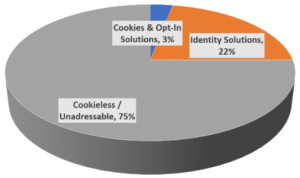
Apple Users vs the rest
The anticipated post-cookie-era and the fascination with the demise of the third-party-cookie continues to dominate the agency conversations, but this is all centered around Google Chrome. Now, Google Chrome is a major web browser, but it is not the only web browser. Here is a breakdown of browser market share from Oberlo.com (https://www.oberlo.com/statistics/browser-market-share):
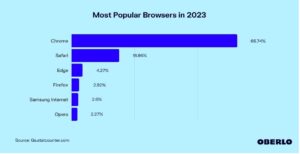
So we know Chrome dominates browser usage, butwhat about that 18% from Safari? And the 2% from Firefox? What about this 20%?. And, do we think these folks use iPhones or Android devices?
This report says iPhone’s are about 25% of the market: https://www.bankmycell.com/blog/android-vs-apple-market-share/. Now, to keep things simple, we will talk about the Apple Universe as 20% of the overall market. That takes into account browsers and mobile devices and is probably a bit conservative. Now, what is interesting about this Apple group? Apple removed Cookies in 2019! From March 24th, 2020: “The latest version of Safari for iOS, iPadOS and macOS now blocks all third-party cookies by default. And, Firefox started blocking cookies by default by June 2019. If cookies are not available on Apple Devices and have not been for years, then we should be able to do some basic research into this group already!
Some details on our Cookie-Less Tool: Pontiac ART
For our experiment focusing on the Apple Users, we need to introduce the Pontiac Audience Research Tool, or Pontiac ART for short. The Pontiac ART tool is designed to deliver Cookieless Targeting Solutions based on a variety of 1st party data or audience characteristics from the advertiser’s ideal target user. This self-service tool allows clients to place a pixel on their website and the pixel simply collects information about the ZIP CODES of the users visiting the page. Providing insight into where your audience is, what they are watching, and what they are reading, then leveraging that information to build comprehensive geo and contextual targeting plans to reach like-minded users.
The entire tool is centered around ZIP CODES, aggregating and analyzing data by ZIP to build privacy-compliant audience profiles and targeting plans unique to each Advertiser that scale across all platforms, media types, browsers, and you guessed it – device types. Leveraging AI for deep contextual analysis, Pontiac indexes content consumption for both full URLs & CTV inventory by greater categories across the U.S. to build cookieless interest data according to what users are reading or streaming by zip code. This provides Advertisers with a platform to easily create the profile of a user with the strongest affinity for their brand by selecting from a list of demographics and interest categories (or simply place a pixel to build this profile from site traffic), then build a comprehensive targeting plan for Display, Video, CTV, DOOH etc, to reach this audience through the Zip Codes they’re in, or the channels, shows, and websites they frequent.
For example, select household income of $150,000+ and content category ‘Luxury Cars’ to find the Zip Codes that have an above average composition for this demographic and are currently reading about this topic. Build a detailed CTV targeting plan leveraging insights into the Channels, Networks, Publishers & Apps this audience is watching. Pair this targeting with display campaigns across Pontiac’s Contextual AI audiences in the Automotive category for well-rounded cookieless targeting that both scales and performs.
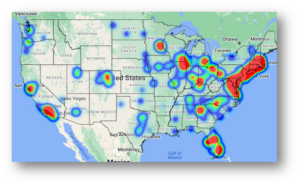
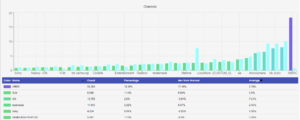
Our Experiment
Before 3rd party cookies are totally deprecated, we can run some basic tests to gain insight into the penetration of all audiences and see how the “Apple Users” are targeted. For our test we ran an open campaign on a broad variety of websites. We did not implement cookie-based frequency caps since the DSP then requires that all users have cookies in the interest of managing frequency. We implemented an IP based frequency cap which ensures no IP address sees too many of the same ad or blows through any frequency requirements from the buyer.
The test used some typical 3rd party data segments available from the largest and most common data companies on the market. For comparison, we built a Pontiac ART targeting plan for the client’s ideal audience profile, our targeting included a combination of specific URLs for contextual placement as well as the Zip Codes currently showing interest in the subject by reading or streaming the most related content. The lines were similar in all other aspects to keep the test fair.
Results of Experiment
23% versus 6%
At the end of the day, the 3rd party data targeting lines using Cookies only reached Apple Devices 6% of the time, while the Pontiac ART data reached the audience 23% of the time, which is far more in line with the actual number of Apple Users both on Desktop and Mobile. While there was improved performance on the Pontiac ART line as well, this test was simply about the gap in most marketers’ plans when approaching Apple Users. This must be considered and harnessed as the cookie goes away and The Apple Users remain a tremendous focus here at Programmatic Mechanics and Pontiac Intelligence.
Why IP Frequency Capping Works for the Apple Audience or Cookie-less Audience
Pontiac has built in a tool which also stores the IP address locally and ensures that we do not serve to the same IP address more than 5 times per day. This allows our tool to also ensure that we don’t waste over exposing one household to the same advertisement. There is much debate as to the accuracy and compliance issues of using IP address to target users, but by using this simply to ensure there is not much waste, we are able to implement as a stop gap over the top and works very nicely to ensure we are getting scale through Apple Users when we run campaigns. It is especially important when we run campaigns ONLY reaching Apple Users.



